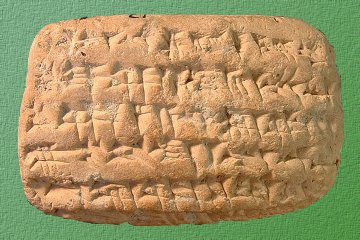The Alibi Receipt
Receipts are useful things. Not only do they allow you to prove your expenses to the taxman, but many a criminal has been convicted because of the receipts found in his pockets - and many a suspect has been proven innocent on the same basis. It is almost a cliche for an erring husband to be found out when his wife notices a receipt for a hotel room she didn't know about, but it is not often that the Bible is proven correct by a receipt.
According to the Bible, the last king of Judah was Zedekiah. The prophet Jeremiah pleaded with him to submit to the Babylonian army which was besieging Jerusalem, but his officers persuaded him to resist. The result was that the Babylonian soldiers broke into the city and captured zedekiah who had tried to escape to Jericho. Zedekiah's sons were put to death in front of the king and he had his eyes put out. He was taken as a prisoner of war to Babylon.
The main features of this Bible record have been confirmed by Babylonian records. A cuneiform tablet tells of the Babylonian triumph and there is evidence that the Jews were sent into exile to Babylon, but what about the details of the story? Are they historicaly reliable?

| |
| Dr Michael Jursa, the Austrian scholar who discovered the Nabu-Sarsekim table. |
Not many scholars in the world are able to read the cuneiform script. It was usually made by a scribe using a stylus, a slim shaft with a triangular tip, which was pressed into soft clay. Of course each impression was exactly the same. The words were formed by using a cluster of impressions to denote a sound. There were some 800 such combinations, so it is little wonder that only a handful of scholars have undertaken the task of reading the cuneiform script.
One such scholar is Dr Michael Jursa of Austria. He decided to translate some of the thousands of cuneiform tablets in the British Museum that have never been studied. It is an arduous task, as most of the tablets are boring commercial records - invoices, receipts, inventories and temple records.
Jeremiah's record states, "In the ninth year of Zedekiah king of Judah, Nebuchadnezzar king of Babylon and all his army came against Jerusalem and besieged it." (Jeremiah 39:1) Zedekiah came to the throne in 597 BC, so this would be January 15, 588 BC.
Jeremiah continues, "In the eleventh year of Zedekiah, in the fourth month, on the ninth day of the month, the city was penetrated." (Jeremiah 39:2) That would be July 19, 586 BC. All very detailed and specific and if Jeremiah's dates were unreliable, he would be thoroughly discredited by now because of the detailed knowledge we have of Babylonian history. But things get even more detailed.
"Then all the princes of the king of Babylon came in and sat in the middle gate. Nergal-Sharezer, Samgar, Nebo-Sarsechim, Rabsaris, Nergal-Sharezer, Rabmag, with the rest of the princes of the king of Babylon." (Jeremiah 39:3)

| |
| The Nabu-Sarsekim Tablet, which confirms the identity of a Babylonian official mentioned in Jeremiah. |
As Dr Jursa pored over his boring clay tablets he was suddenly electrified. There was the name "Nebo-Sarsekim". Dr Jursa said, "The clay document is dated to the 10th year of Nebuchadnezzar II, 595 BC and names the official Nebo-Sarsekim. According to chapter 39 of the book of Jeremiah, he was present at the siege of Jerusalem in 587 BC with Nebuchadnezzar himself. To find a cuneiform reference to someone connected with these remarkable times is rare, but evidence from non-Biblical sources for the existence of any individual named in the Bible - other than kings - is incredibly rare."
There are some differences in the texts. Dr Jursa is of the opinion that the name should be pronounced "Nabu-sharrussu-ukin". There is no conflict with the Biblical name here as there were no vowels in Hebrew and except for the last letter, the consonants are the same. Modern Bible translators were not to know what sounds to insert; they did the best they could. Cuneiform, on the other hand, does have vowel sounds, so Dr Jursa has been able to spell it out.
Jeremiah called these officials sariy, translated "princes" in the Bible. A similar Hebrew word is translated "enuchs" and that is what this cuneiform tablet calls them. Eunuchs were common in ASsyria and Babylon and they often held high positions in the government. Actually the prophet Daniel may have become a eunuch when he was exiled to Babylon. Daniel and his companions were committed to the care of "the master of the eunuchs (sariym)" Daniel 1:3, 6.
Dr Jursa added, "Finding something like this tablet, where we see a person mentioned in the Bible making an everyday payment to the temple in Babylon and quoting the exact date is quite extraordinary."
Irving Finkel, Assistant Keeper in the Department of the Middle East at the British Museum, had this to say about the find: "Cuneiform tablets might all look the same but sometimes they contain treasure. Here a mundane commercial transaction takes its place as a primary witness to one of the turning points in Old Testament history. This is a tablet that deserves to be famous."
© David Down 2007





